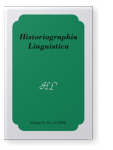Remarks on Dionysios Thrax’s concept of ‘Diáthesis’
The purpose of this paper is to present a new interpretation of Dionysios Thrax’s original definition of diáthesis. Diáthesis was regarded as one of seven morphological categories of the (finite) verb of which there were two and only two formal variants, i.e., enérgeia “performance” and páthos “experience” (generally referred to as the active and middle sets of personal endings respectively). Diáthesis was manifested in the personal ending of the verb, whose function was to represent various properties of the ‘subject’, i.e., its person and number as well as its diáthesis “disposition” – or general thematic relation – to the verb. The morpheme for the diáthesis enérgeia “performance” exhibited the active set of personal endings as its ‘form’ and expressed the person and number of the subject as well as the fact that it ‘performed’ the predication as its ‘schematic’ meaning; the morpheme for the diáthesis páthos “experience” exhibited the middle set of personal endings as its ‘form’ and expressed the person and number of the subject as well as the fact that it ‘experienced’ the predication as its ‘schematic’ meaning. Moreover, just as the other Greek (and Roman) grammarians, so too was Dionysios Thrax well aware of instances in which there was a discrepancy between ‘form’ and ‘meaning’. Accordingly, he incorporated such ‘anomalies’ into his definition by mentioning four concrete examples and labeling them with his technical term mesótēs “middle”: the first two examples were active forms which exhibited the meaning of páthos, whereas the second two examples were middle forms which exhibited the meaning of enérgeia.
References
Allwood, Jens, Lars-Gunnar Andersson & Östen Dahl
1977 Logic in Linguistics. Cambridge: Cambridge Univ. Press.


Andersen, Paul Kent
1989a “
Gibt es Passivmorphologie?”.
Linguistische Berichte No. 1211.185–205.

Andersen, Paul Kent
1989b “
Remarks on the Origin of the Term Passive”.
Lingua 791.1–16.


Andersen, Paul Kent
1991 A New Look at the Passive. Frankfurt a. M.: Peter Lang.

Andersen, Paul Kent
1992 “
Aktive Passivkonstruktionen im Altgriechischen: Ein Beitrag zur Pragmatik”. Ms., Univ. of Bielefeld.

Andersen, Paul Kent
1993 “
Eine alternative Sprachtypologie für das Reflexiv”.
Folia Linguistica 271.107–146.


Andersen, Paul Kent
In press. “
Zur Diathese”. To appear in
Historische Sprachforschung.
Bolinger, Dwight
1977 Meaning and Form. London: Longman.

Chomsky, Noam
1981 Lectures on Government and Binding. Dordrecht: Foris.

Collinge, N. E.
1963 “
The Greek Use of the Term ‘Middle’ in Linguistic Analysis”.
Word 191.232–241.


Delbrück, Bertold
1897 Vergleichende Syntax der indogermanischen Sprachen. Zweiter Theil. Strassburg: Karl J. Trübner.


Geniušiene, Emma
1987 Typology of Reflexive Constructions. Berlin: Mouton de Gruyter.


Haiman, John
ed. 1985b Natural Syntax. Cambridge: Cambridge Univ. Press.

Hermodsson, Lars
1952 Reflexive und intransitive Verba im älteren Westgermanischen. Uppsala: Almqvist & Wiksells.

Hilgard, Alfred
ed. 1894 Theodosii Alexandrini Canones. Georgii Choerobosci Scholia. Sophronii Patriarchae Alexandrini. (=
Grammatici Graeci IV: 1–2) Leipzig: B. G. Teubner.

Hilgard, Alfred
ed. 1901 Scholia in Dionysii Thracis Artem Grammaticam. (=
Grammatici Graeci 1:2.) Ibid.

Jankuhn, Harald
1969 Die passive Bedeutung medialer Formen untersucht an der Sprache Homers. Göttingen: Vandenhoeck & Ruprecht.

Kalbfleisch, Karl
ed. 1907 Simplicii in Aristotelis Categorias Commenat-rium. (=
Commentaria in Aristotelem Graeca, 8.) Berlin: G. Reimer.


Keil, Heinrich
ed. 1855–1880 Grammatici Latini. 81 vols. Leipzig: B. G. Teubner. (Repr., Hildesheim: Georg Olms 1961.)

Koivisto, Vesa
1989 “
Semantics of Karelian Reflexive Verbs”.
Proceedings of the Fifth International Finno-Ugrist Students’ Conference, Helsinki, 22–26 May 1988 ed. by
Riho Grünthal,
Sirpa Penttinen &
Tapani Salminen, 51–58. Helsinki: Castrenianum Complex of the Univ. of Helsinki Finno-Ugrian Society.

Kuryłowicz, Jerzy
1964 The Inflectional Categories of Indo-European. Heidelberg: Carl Winter.

Langacker, Ronald W. & Pamela Munro
1975 “
Passives and Their Meaning”.
Language 511.789–830.


Lyons, John
1968 Introduction to Theoretical Linguistics. Cambridge: Cambridge Univ. Press.


Neu, Erich
1985 “
Das frühindogermanische Diathesensystem. Funktion und Geschichte”.
Grammatische Kategorien: Funktion und Geschichte. Akten der VII. Fachtagung der Indogermanischen Gesellschaft. Berlin, 20.-25. Februar 1983 ed. by
Bernfried Schlerath, 275–295. Wiesbaden: Ludwig Reichert.

Newmeyer, Frederick J.
1992 “
Iconicity and Generative Grammar”.
Language 681.756–796.


Polenz, Max
1970 Die Stoa: Geschichte einer geistigen Bewegung. 41. Auflage. Göttingen: Vandenhoeck and Ruprecht.

Robins, R[obert] H.
1993 The Byzantine Grammarians: Their place in history. Berlin: Mouton de Gruyter.


Schauwecker, Ludwig
1960 “
Die genera verbi im Französisch/Provenzalis-chen”.
Zeitschrift für französische Sprache und Literatur 701.49–83.

Schiefer, Erhard
1983 Überlegungen zur Tauglichkeit des Passivbegriffs und bisheriger Passivuntersuchungen, mit besonderer Berücksichtigung finnisch-ugrischer Sprachen. Wiesbaden: Otto Harrassowitz.

Schwyzer, Eduard
1950 Griechische Grammatik. Zweiter Band: Syntax und syntaktische Stilistik. Ed. by
Albert Debrunner. München: M. C. Beck.

Shibatani, Masayoshi
1985 “
Passives and Related Constructions: A prototype analysis”.
Language 611.821–848.


Uhlig, Gustav
ed. 1883 Dionysii Thracis Ars Grammatica. (=
Grammatici Graeci I:1.) Leipzig: B. G. Teubner.

Uhlig, Gustav
ed. 1910 Apollonii Dyscoli quae supersunt. (=
Grammatici Graeci II:2.) Ibid.

Xolodovič, A. A.
1970 “
Zalog [Voice]”.
Kategorija zaloga: Materialy kon-ferencii, 2–26. Leningrad.

Cited by
Cited by 3 other publications
Benedetti, Marina
2014.
Pourquoi l'appelle-t-on moyen ? Apollonius Dyscole et les « figures moyennes ».
Langages N° 194:2
► pp. 9 ff.

Pacchiarotti, Sara & Leonid Kulikov
2022.
Bribri media tantum verbs and the rise of labile syntax.
Linguistics 60:2
► pp. 617 ff.

This list is based on CrossRef data as of 30 march 2024. Please note that it may not be complete. Sources presented here have been supplied by the respective publishers.
Any errors therein should be reported to them.
